Pool Observations
From our experience, the chances of success of a program are higher if it is scheduled in a pool than in the traditional way of dedicated observing blocks. This is due to the flexibility of pooled observations concerning demand on weather quality and equipment availability. It is therefore advantageous for any project to participate in these pooled observing sessions. This means that the volunteer observers appointed in a given shift will receive from the pool managers a compendium of the observing projects to be tackled, depending on weather conditions, science targets visibility, project priorities and progress levels, etc. Participation in the pools is of additional interest for low-rated proposals that may otherwise not be scheduled. Astronomers with little or no experience are welcome as visitor observers at the IRAM 30m radio telescope.
Contents
Go to the NIKA2 main page.
Pool Logistics
Pool observations are carried from a dedicated pool account (ask the AoD for the login information of the NIKA2 account in force). Each project has a folder within the home directory of the pool account with instructions on how to proceed. Read carefully the README file before starting. For example, see the file ~/001-17/README_001-17.txt.
Choose a project
First log into the IRAM 30m pools webpage (the PIs of a scheduled project can also access the database by using the login information of their project) and click on the NIKA2 tab.
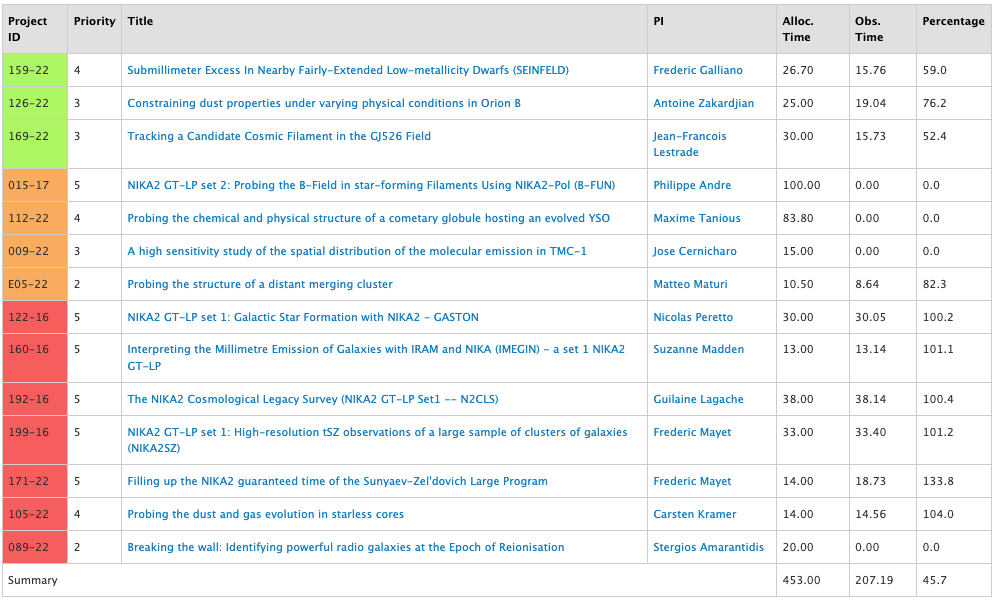
Projects have different priorities from 5 (highest priority) to 1 (lowest priority). Green color indicates that the project is scheduled, orange that the project is on hold, and red that the project is finished. Only green projects should be observed. To check the visibility of these projects go to the visibility tab:
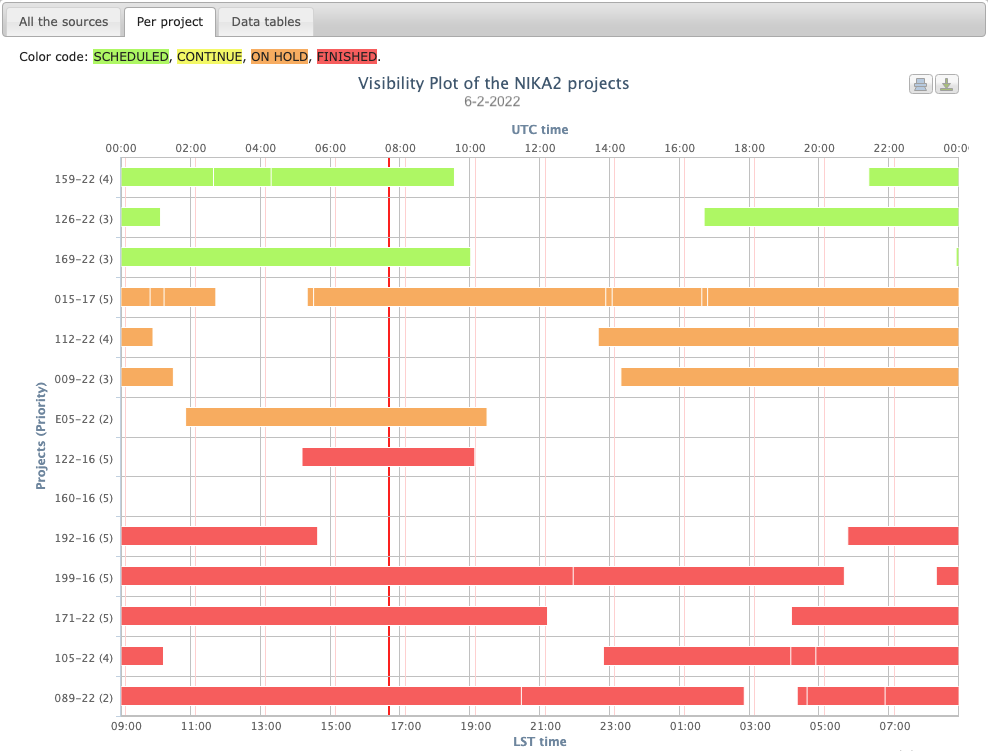
The red vertical line corresponds to the current time (UT). In case none of the priority 5 projects have weather requirements (see the README files) compatible with the current conditions, go for priority 4 projects and so on, or according to the instructions given by the AoD.
Finally, the IRAM 30m pools webpage can show you in real time a summary of the scans obtained per project by simply clicking on the project name and then on the "Logsheets" tab. The table obtained (see an example below) is an extract of the records automatically stored in the TAPAS server after each scan, together with the comments provided by the observer.
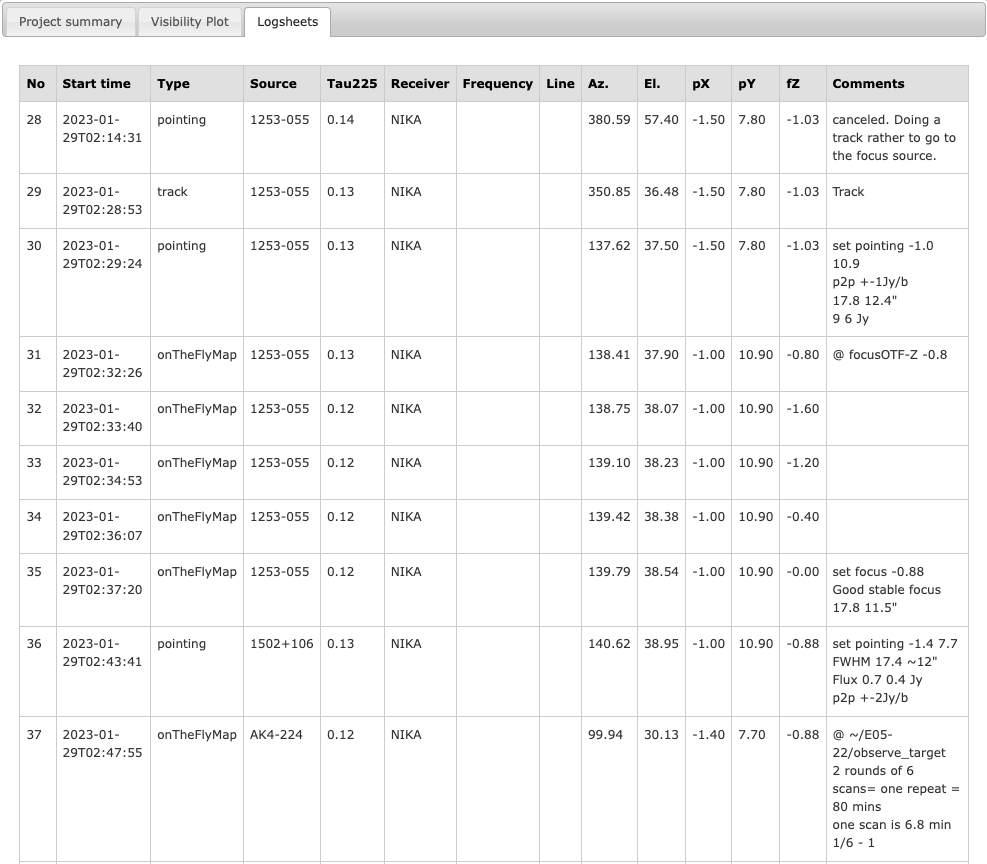
Take some time to explore all the dimensions of this useful database. In case of doubts, ask the AoD.
Visibility of flux standards
Among the calibration scans to be carried out over selected NIKA2 pool shifts (see Observing session site), daily observations of flux standards are essential. Below are some plots of the planets and secondary flux calibrators suitable to be observed with NIKA2. The catalog of the latter ones (CalibNIKA.sou) is available in the pool account. All former secondary calibrators are listed here: http://www.iram.es/IRAMES/mainWiki/Continuum/Calibrators#preview.
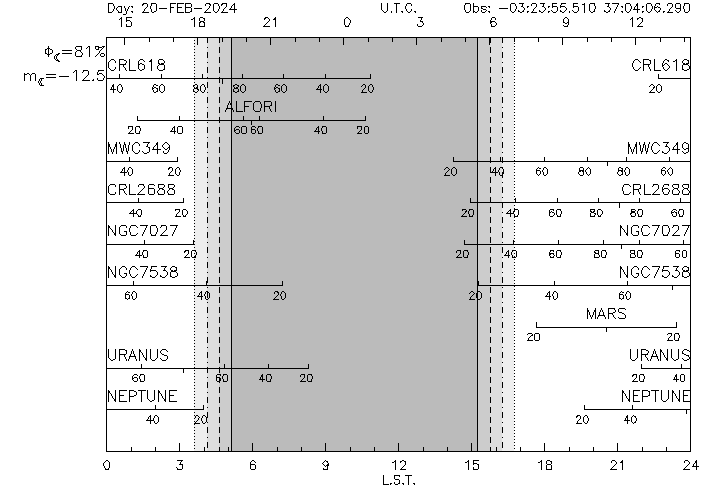
Project setup
The standard method to set the project is:
PAKO> set project XXX-YY
However, for pooled observations, this is often done using a setup script (see for example setup_001-17.pako). For example, before starting to observe the project 001-17 you should type:
PAKO> @ ~/001-17/setup_001-17.pako
It is IMPORTANT to set the project accordingly before each observation in order to identify the scans observed for each project, keep control on the time used to observe each project, and write the data files in the right directory.
Pool-Account usage: Accounting of observing times
Calibration observations like pointing, focus which are conducted before and during project observations are part of the project time. Note that all proposals include such overheads in the time and sensitivity estimates. This holds for total power and polarimetry observations.
calib_1scan for characterizing the instrumental polarization are to be accounted to the project.
Other calibration observations which are important for *all* projects like beam maps, skydips, or calib_1scan for absolute flux calibration on primary and secondary calibrators may be accounted under the pool account (nikaX-YY, where X = s,w and YY = year).
- When conditions are unstable and it is unclear whether project observations make sense at all, calibrations may be accounted to the pool account.
Catalog of sources
Before starting to observe a certain project it is necessary to load its catalog of sources. Usually, this is automatically done within the setup script. If for some reason you need to load the catalog manually, type:
PAKO> SOURCE CATALOG 001-17.sou
This command will load the catalog 001-17.sou with the position of NGC4449. To select this source, just type:
PAKO> source NGC4449
To select a source from the IRAM catalog of pointing sources, just type:
PAKO> source pointing_source /cat * (or "iram-J2000.sou" for the given catalog)
Scripts preparation
Pooled observations should be fairly straightforward to observe. Note that your project will NOT be observed in case you do not send your observing instructions to the NIKA2 Pool Manager before the begin of the pool. It is highly recommended to use the standard scripts provided by the IRAM staff:
Note that this script uses a non-optimal scan size. For the optimum scan size, see the recommendation below. You can download these example scripts and adapt them to your project. If you have questions please contact the pool manager.
Recommended scan sizes for science projects
To optimize the correction of data instabilities, the length of NIKA2 sub-scans, i.e. the size of scans along the scan direction should be at least:
NIKA2 FOV (6.5') + 2 * NIKA2 beam width (12" at 1mm, 18" at 2mm) + source size above the noise + 2s * scan speed
The third term makes sure that KIDs instabilities are properly corrected by data reduction. The fourth term is added because known tracking deviations of the 30m telescope can hinder the quality of data records, up to 2s after the beginning of each sub-scan.
Perpendicularly to the scan direction, there is no minimum size limit, but too long scans can expose to a risk of losing tuning in the Data Acquisition System over time.
Note that the size computed in this way is the Delta(x) described in the exposure time calculator documentation and not the size of the final map. The latter is larger by one FOV size.
Pointing Sources
It is possible to select pointing sources nearby to your science targets using XEphem and the IRAM 30m Catalog for Continuum Cameras. Additional SMA continuum pointing sources (> 1 Jy at 1 mm) are included among the catalogues.
Mapping modes
We offer the on-the-fly (OTF) observing mode for the NIKA2 camera where data are taken continuously while the telescope follows a zig-zag pattern. The mode can be commanded as follows:
PAKO> @ nkotf xSize ySize posAngle tiltAngle otfStep otfSpeed System
where xSize and ySize are the size of the otf map in arcminutes, posAngle determines the angle of the scanning direction (anti-clockwise), tiltAngle determines the inclination of the scanning direction (anti-clockwise, useful to map filaments), otfStep is the spacing between OTF lines, otfSpeed is used to set the scanning speed (in arcseconds/sec), and System set the reference coordinate system (radec or azel). The nkotf command allows to generate plenty of different scanning patterns. In the following, some examples are shown. See also the last section of the wiki Observing with NIKA2.
PAKO> @ nkotf 5 5 0 0 20 40 azel
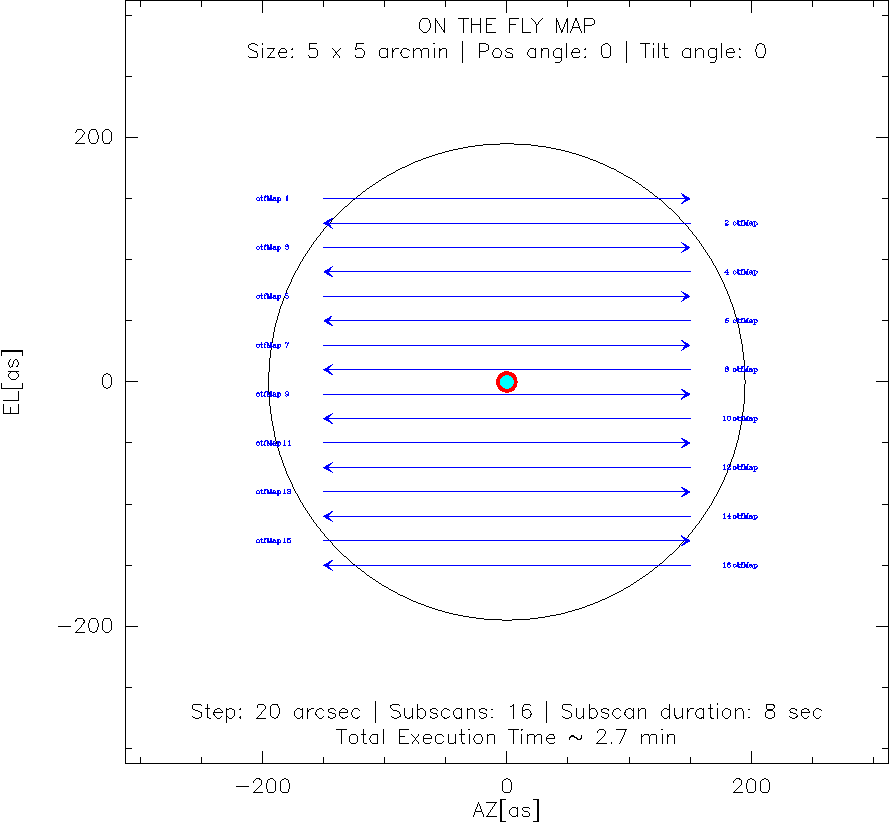
PAKO> @ nkotf 8 8 45 0 20 40 radec
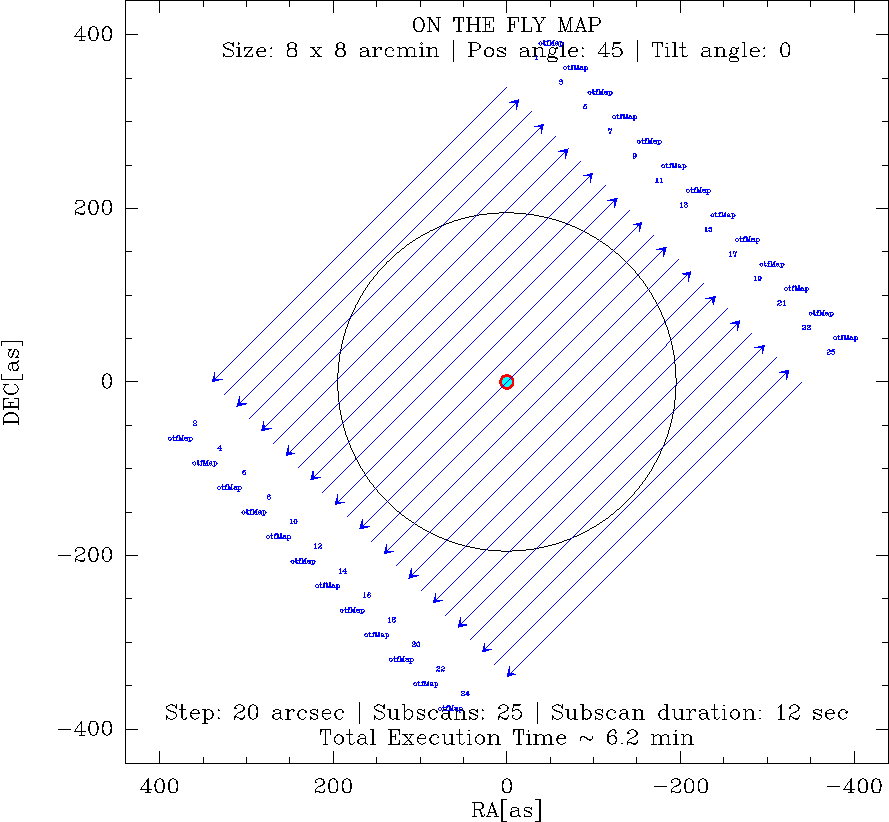
PAKO> @ nkotf 2 12 30 +30 20 40 radec PAKO> @ nkotf 2 12 30 -30 20 40 radec
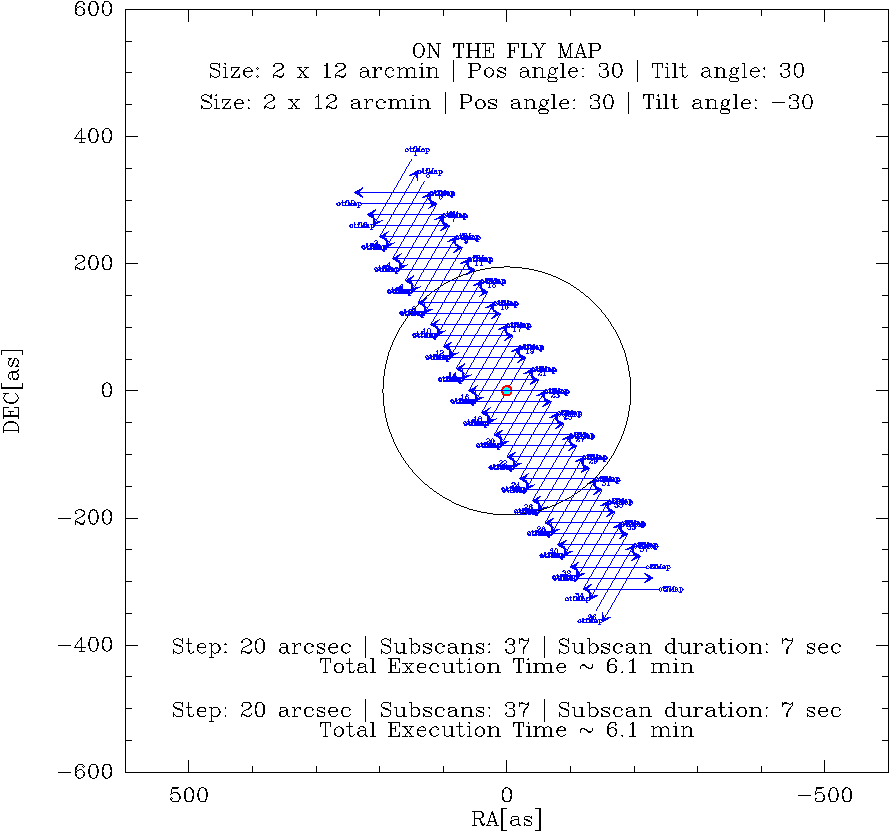
Contact: Angel Bongiovanni, Ioannis Myserlis, Stergios Amarantidis (NIKA2 NIKA2 Pool Management)
email: bongio@iram.es, imyserlis@iram.es, samarant@iram.es
Created: 2013.OCT.25, H. Hermelo
Updated: 2019.DEC.16, B. Ladjelate
Last update: 2024.JAN.30, A. Bongiovanni
